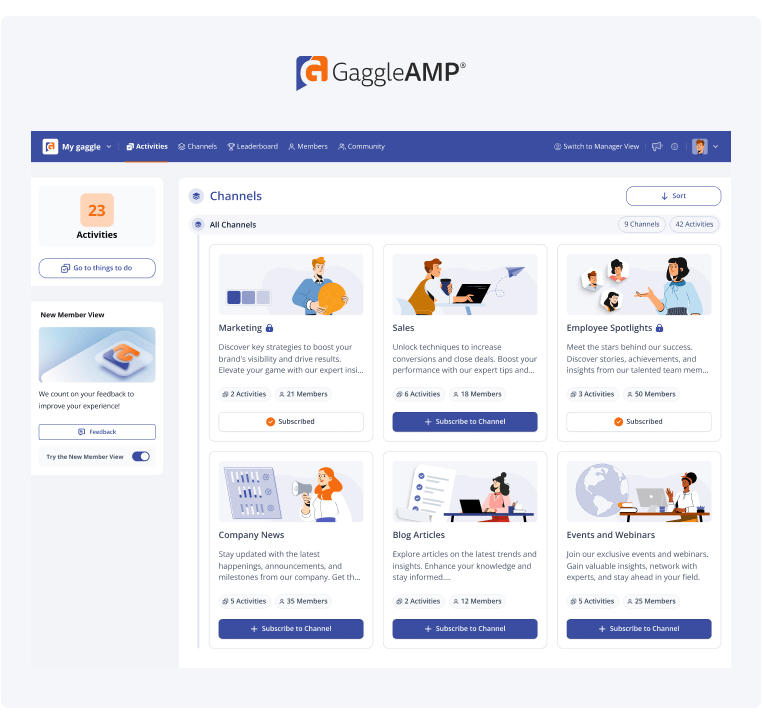Introduction to Social Media in the Workplace
Social media is no longer just a part of our personal lives; it also plays a significant role in the workplace.
From boosting employee engagement to posing potential security risks, the influence of social media in professional settings is both significant and multifaceted.
To really make the most of it — and avoid any hiccups — it's important to get a good grasp on how social media impacts our professional world.
In this article, we’ll explore the benefits of social media like improved employee engagement and advantages in recruitment, alongside potential pitfalls like decreased productivity and legal issues.
We’ll also provide practical tips on developing social media policies and using social media to your advantage.
Let’s get started!
The Pros of Social Media in the Workplace
Social media can be a powerful tool in the workplace when used effectively. Let's explore some of the advantages that it offers.
Boosts Employee Engagement
Social media can significantly enhance communication and collaboration among employees. Platforms like Slack and Microsoft Teams enable instant messaging, video conferencing, and group chats to foster a sense of community and team bonding.
These tools make it easier to share ideas, provide quick feedback, and keep everyone on the same page.
For instance, a project team can create a dedicated channel to brainstorm ideas, share progress updates, and celebrate small wins, keeping the team motivated and engaged.
Social media also facilitates cross-departmental interactions, breaking down silos and promoting a more cohesive work environment.
Supports Recruitment and Employer Branding
Social media is a powerful tool for recruitment and employer branding. Companies can use platforms like LinkedIn, Facebook, and Instagram to attract top talent and showcase their workplace culture.
HubSpot, for instance, uses Instagram to highlight its work environment, employee experiences, and company values, which appeal to potential candidates who identify with its culture.

Source: HubSpot
Companies can build a compelling employer brand that resonates with job seekers by sharing stories about employee achievements, behind-the-scenes glimpses, and company events.
Social media also allows companies to reach a broader audience, including passive candidates who may not be actively looking for a job but are open to new opportunities.
In fact, job seekers are increasingly relying on social media for job hunting. 58% of them use social media to research potential employers, while 48% of both Gen Z (born between 1997-2012) and Millennials (born between 1981-1996) with work experience have applied for jobs they discovered through social media platforms.
Provides Mental Breaks
Allowing employees to take short social media breaks can help them recharge and reduce stress. Research has shown that short breaks can prevent burnout and reduce fatigue, making social media an effective tool for maintaining employee well-being.
According to a survey by Monster, 22% of workers use social media to take mental health breaks during work. A few minutes browsing social media can provide a much-needed respite from intense work tasks and help employees return to work with renewed focus and energy, improving overall job satisfaction and productivity.
The Cons of Social Media in the Workplace
While social media offers numerous benefits, it also presents some challenges that can negatively impact the workplace.
Affects Productivity
One of the most significant drawbacks of social media in the workplace is its potential to distract employees.
While short social media breaks can boost engagement, too much time on social media can become a major time-waster. Employees might spend excessive amounts of time scrolling through personal feeds, watching videos, or engaging in non-work-related conversations.
Data reveals that the typical working-age internet user spends about two hours and 27 minutes daily on social platforms.
This lost time can lead to decreased productivity, missed deadlines, and a general decline in work quality.
Creates Security Risks
Social media can pose significant security risks for companies. Employees sharing company updates, photos, or even seemingly harmless information can inadvertently expose sensitive data.
For example, a picture of a team meeting might reveal confidential documents in the background, or a casual mention of a project deadline could provide competitors with valuable insights.
Social media platforms are also prime targets for cyber attacks, and a hacked social media account can fetch upwards of $45. Business is conducted on LinkedIn all the time, and hackers realize a hacked account is a valuable commodity.

Source: StationX
In recent times, phishing schemes, malware, and social engineering attacks have all been used to exploit social media activity of employees and gain access to company systems and data.
Legal and Ethical Issues
The use of social media in the workplace can also lead to legal and ethical challenges. Negative comments or inappropriate behavior on social media can have severe repercussions for both employees and the company.
For instance, an employee posting derogatory remarks about a colleague or the company can lead to defamation claims or create a hostile work environment, exposing the company to legal liabilities.
Breaches of confidentiality, intellectual property violations, and non-compliance with industry regulations are some of the other issues that can result in legal actions against the company.
Ethical issues such as spreading misinformation or using social media for personal gain at the company's expense can also damage its reputation and trustworthiness.
Developing a Social Media Policy
A well-defined social media policy can help protect a company, its employees, and its reputation. Here are some key elements and strategies for effective implementation and communication.
Key Elements To Include
A comprehensive social media policy should clearly outline what is expected of employees when using social media, both professionally and personally.
It must include:
-
Acceptable Use Guidelines. Define what constitutes acceptable use of social media during work hours. Specify whether employees can access personal social media accounts and, if so, to what extent.
-
Example: Employees are allowed to check personal social media accounts during breaks, but extensive use during work hours is prohibited.
-
-
Confidentiality and Privacy. Outline the importance of protecting sensitive company information. Employees must understand what information is considered confidential and should not be shared online.
-
Example: Employees must avoid posting internal documents, financial information, or project details on social media platforms.
The case of Lexi Larson is a prime example. The TikToker shared her earnings and tax details online, only to be fired from her new tech job for divulging her salary, she later claimed.
-

Source: New York Post
-
Professional Behavior. Set clear expectations for maintaining professionalism on social media. This includes refraining from posting negative comments about the company, colleagues, or clients.
-
Example: If you're frustrated with a project, discuss it with your manager instead of venting about it on Facebook or X.
-
-
Brand Representation. Provide guidelines on how employees can represent the company online. Encourage them to share company achievements and positive news while adhering to the branding guidelines.
-
Example: When sharing a company event on LinkedIn, use the official event hashtag and approved graphics to maintain brand consistency.
-
-
Crisis Management. Include procedures for handling social media crises or negative publicity. Designate a team responsible for managing the company's social media response during a crisis.
-
Example: In the event of a social media crisis, employees should direct all inquiries to the designated crisis management team and avoid posting any unofficial statements.
-
Implementation and Communication
Clear communication and ongoing training are essential to ensure all employees understand and adhere to your company’s social media policy.
Here are some strategies to help with implementation and communication.
-
Clear Communication. Roll out the social media policy through multiple channels to ensure all employees receive the information. This can include email announcements, intranet postings, and printed handouts. It can also be included as part of new employee onboarding paperwork.
Don’t forget to follow up with a team meeting to discuss its importance and answer any questions.
-
Training Programs. Conduct regular training sessions to educate employees about the social media policy. These sessions can provide practical examples and address any questions or concerns.
For example, a training session might include a role-playing activity where employees practice responding to a negative social media comment in a way that aligns with the company’s values.
-
Regular Reminders. Reinforce the policy through periodic reminders and updates. Use team meetings and digital signage to keep the guidelines at the top of employees’ minds.
You can also include a ‘Social Media Tip of the Month’ in the company newsletter to remind employees of key policy points, like respecting privacy settings and being mindful of what they share.
-
Accessible Resources. Make the social media policy easily accessible to all employees. Create a dedicated page on the company intranet where employees can find the social media policy, FAQs, and contact information for further assistance.
-
Feedback Mechanism. Establish a system for employees to provide feedback on the social media policy. This can help identify areas for improvement and ensure the policy remains relevant and practical.
Leveraging Social Media for Business Benefits
Companies can significantly enhance their reach, reputation, and internal communication by encouraging employee advocacy and promoting knowledge sharing and collaboration.
Employee Advocacy Programs
An employee advocacy program encourages your workforce to share company content on their personal social media profiles.
This practice extends your company's reach and enhances its reputation through the authentic voices of its employees.
Here’s how you can go about managing such a program.
-
Create Shareable Content. Develop engaging and relevant content that your employees will be proud to share. This can include company news, industry insights, or employee success stories.
If your employee shares a LinkedIn post about a recent company award, for instance, it will reach hundreds of connections who might not have seen the original company post.
-
Encourage Participation. Foster a culture where employees feel valued and motivated to participate in advocacy. This is important, as research by Gallup shows that companies with top-quartile employee engagement have 23% higher profitability and 70% higher employee well-being.
Don’t forget to recognize and reward employees who actively share content.
-
Use Tools Like GaggleAMP. Implement tools like GaggleAMP to streamline and manage the advocacy process. These platforms can help distribute content to employees, track sharing metrics, and measure the impact.
Knowledge Sharing and Collaboration
Companies can enhance their collective expertise and innovation by creating spaces for employees to share knowledge and discuss industry trends.
-
Set Up Channels. Create channels for different departments, projects, or topics to organize discussions and make it easy for employees to find relevant information.
For example, you can set up a Gaggle Channel called Company News, where employees can find out more about the latest announcements, milestones, and the state of the company.

-
Facilitate Peer Learning. Encourage employees to share tips, tools, and experiences to promote peer-to-peer learning.
One way of doing this is by encouraging employees to share insights from conferences or webinars they’ve attended. Another is to send out weekly prompts and ask members to share their biggest wins or recent learnings.
-
Create a Resource Library. Record sessions and create a digital library where employees can access past webinars and training materials. These recorded sessions can be shared on the company’s internal social media platform to create a valuable learning resource.
Measuring the Impact of Social Media
Monitoring the following metrics will help companies assess the effectiveness of social media policies and strategies. Here are five key metrics to track:
Key Metrics to Track
-
Employee Engagement Rates. Measure how employees actively participate in sharing and interacting with company content.
High engagement rates, such as the number of employees sharing company posts and the level of interaction (likes, comments, shares), indicate that employees are enthusiastic and invested in promoting the company.
-
Social Media Mentions. Monitor how often the company is mentioned on social media platforms.
Using social listening tools to track mentions of the company’s name, products, or services across various social media channels can provide insights into brand awareness and public perception.
-
Productivity Levels. Assess whether social media use is impacting employee productivity. Compare productivity levels before and after implementing social media policies to identify any significant changes.
Analyzing productivity metrics such as project completion rates and employee performance reviews can help determine the impact of social media use.
-
Brand Sentiment. Evaluate the overall sentiment of social media mentions to understand how people feel about the company.
Conducting sentiment analysis on social media mentions to categorize them as positive, negative, or neutral can highlight areas for improvement and indicate a strong brand reputation.
-
Content Reach and Engagement. Measure the reach and engagement of the content shared by your company and its employees.
This includes tracking the number of views, likes, shares, and comments on posts using analytics tools provided by social media platforms to identify which types of content generate the most engagement.
Enhance Your Workplace Social Media Strategy With GaggleAMP
When used strategically, social media is a powerful tool that can significantly boost a company's internal and external success.
By balancing the pros and cons and implementing effective strategies, businesses can harness the full potential of social media to foster a more engaged, informed, and connected workforce.
Ready to implement a robust social media strategy that works both internally and externally?
GaggleAMP offers comprehensive resources to help you manage and leverage social media effectively.
-
For Internal Teams. Utilize our social media policy template to streamline the creation and communication of your guidelines.
Download the Internal Social Media Policy Template -
For External Teams. Check out our external advocate or influencer example to effectively manage and leverage external social media advocates.
Download External Advocate Example
Start transforming your social media presence and schedule a demo today!










